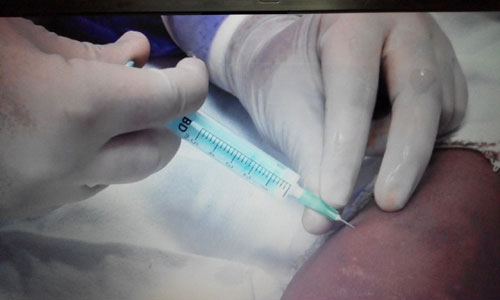|
|
|
Indian Pediatr 2018;55: 612 |
 |
Intra-articular Corticosteroid
Administration
|
|
Narendra Kumar Bagri* and Saroj Kumar Tripathy
Division of Pediatric Rheumatology, Department of
Pediatrics, AlIMS, New Delhi, India.
Email:
[email protected]
|
|
Arthrocentesis and intraarticular corticosteroid
(IACS) administration are simple procedures but often not performed by
pediatricians. Hesitancy in executing this procedure may result in
delayed diagnosis of underlying arthritis, and often delays the
therapeutic benefit of IACS. The most common indication of IACS
injection is Juvenile idiopathic arthritis (JIA), particularly
oligoarticular JIA. We are sharing this video (Fig. 1 and
Web Video 1) to increase awareness among pediatricians about
this elementary technique. The video depicts the procedure of
administrating IACS in a 9-year-old- boy diagnosed as JIA with active
arthritis in left knee joint. The procedure was completed without any
complication and there was symptomatic improvement in pain and swelling
resulting in full range of motion at knee joint without any recurrence
at last follow-up (2 months after the procedure).
 |
|
Fig. 1 Intra-articular corticosteroid
administration.
|
IACS injection is a daycare procedure and does not
require specialized equipments for most of the amenable joints.
Triamcinolone acetonide is available in India for IACS injection, and
the usual dose is 2 mg/kg for large joints and 1-2 mg/joint for smaller
joints. We usually prefer medial retropatellar approach for knee joint.
A 21 or 22G needle attached to 10 mL syringe is advanced through skin,
capsule, and synovial membrane to enter the joint cavity. A ípopí
sensation and aspiration of synovial fluid confirms the right position.
After aspiration, the syringe is detached while leaving the needle in
place, and the IACS loaded in a prefilled syringe is administered. The
needle is swiftly withdrawn, a gentle pressure is applied for 30
seconds, and a sterile bandaid is applied. Joint rest is advised for 48
h after injection to reduce the escape of medicine from the joint, and
improving its anti-inflammatory response.
Acknowledgment: Mr Sanjay Sharma, K.L.WIG,
CMET, AIIMS, New Delhi for his help in shooting and editing the video.
|
|
|
 |
|

